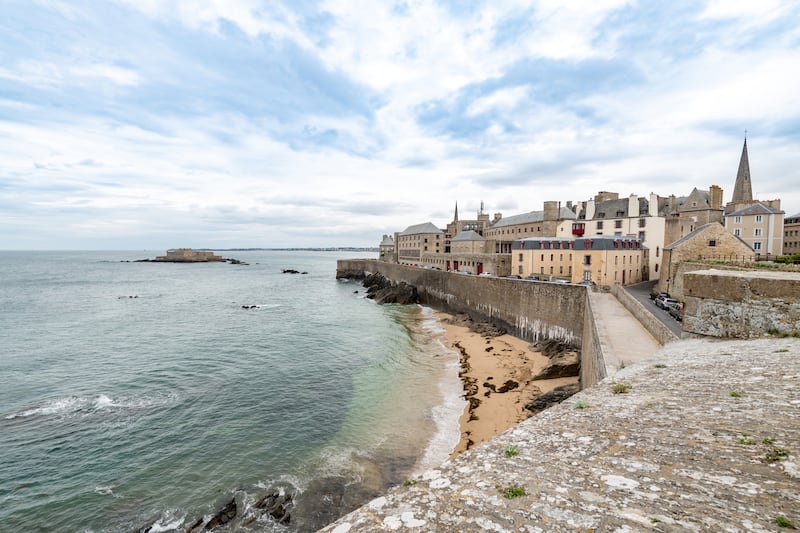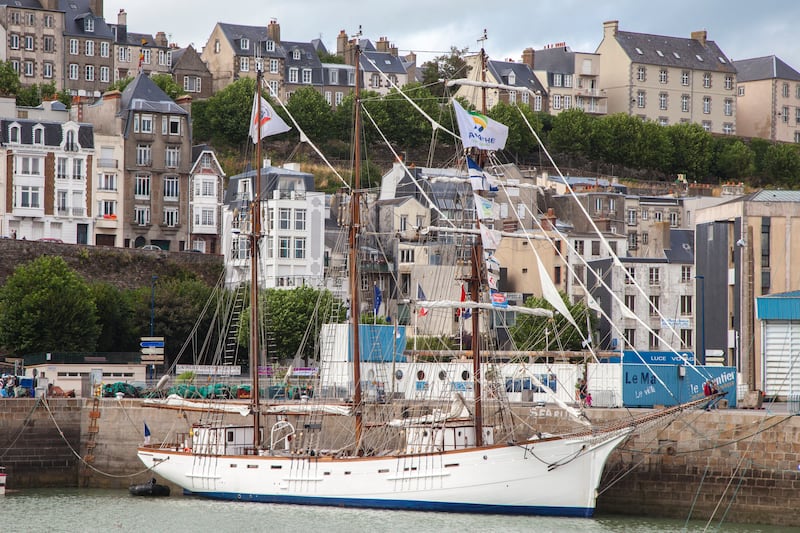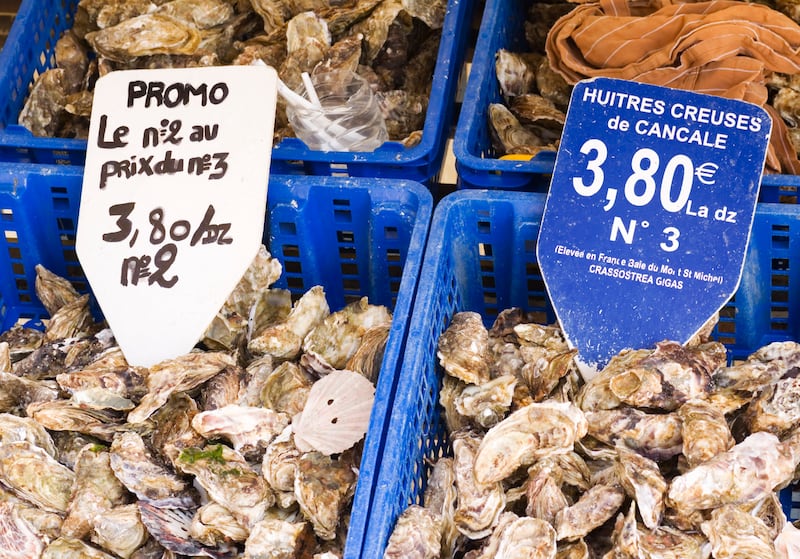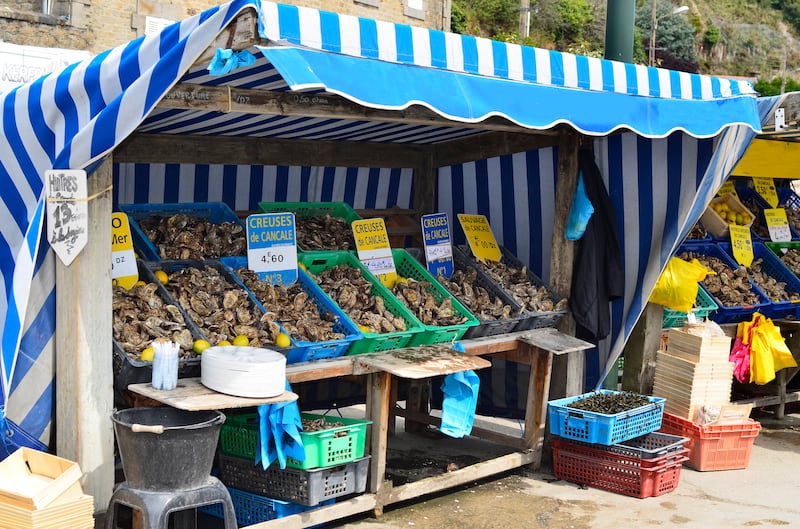Most of us want the same thing from a winter holiday – relief from the endless grey skies and damp days. A ski trip or a jaunt to the Canaries often suffices, but might there be a more ecological alternative?
This question set me sailing out of Dublin Bay on the impressively gigantic Irish Ferries ship, WB Yeats, last January. Its spaciousness and comfort is far removed from the cattle-boat-like ferries one remembers from the 1980s. Two 9m2 stabilising fins, weighing 40 tonnes, help to neutralise the sea roll, making for an exceptionally smooth crossing. While the trip to Holyhead is too short to allow your body fully benefit from the therapeutic effects of being seaborne, the 16-hour sail to Cherbourg offers time to fully orientate the body to its hypnotic rhythms.
It’s a 40-minute walk from the port, or a short taxi trip, to Cherbourg train station, which has frequent links to Paris and beyond. I took a train east to the 19th century seaside resort of Granville, where I settled into a seaside room and began exploring the narrow medieval streets of the haute ville, built into a rocky promontory. It’s rare now to find an ancient medieval quarter that is neither gentrified, nor falling to ruin, nor sacrificed to tourism.

Granville was once a key summer location for the Paris elite and then, later, music fans flocked here for concerts by the likes of Jonny Holiday and Serge Gainsbourg, but the city now offers more authentic cultural experiences to a lesser number of more discerning tourists: one can volunteer to help restore the 12th century L’Abbaye de la Lucerne under the tutelage of the elderly master craftsman who has devoted his life to it, or join the local fishermen sorting, salting and cooking their daily catch of welks.
St Patrick’s Day Quiz 2025: 50 questions to test your Irishology
Adolescence review: A dark and often unbearable insight into the nightmarish extremes of our teenagers’ lives
The 100 best Irish books of the 21st century: No 25 to No 1
Dancing with the Stars finale: Rhys McClenaghan is ‘in another world’ as he beats Jack Woolley to 2025 Glitterball trophy
The best time to visit is for Carnival, when the city goes berserk for five days and nights. People throw open their doors for wild parties to which everyone is invited as long as you’re well-disguised. The bacchanalia reaches a peak at a giant bonfire at which the collective woes and trauma of the community are burnt on a vast platform at sea. It’s a reminder of the upheaval that surrounded the departure of the city’s menfolk to the fishing grounds off Newfoundland every year after Shrove Tuesday for centuries.
Of course, it can’t compare with the Canaries in terms of heat, or with the alps for sunlight, but the January air is drier than Ireland, and there’s far less rainfall. The all-encompassing light is still as alluring as it was for the Impressionists who were drawn here 130 years ago.
The region’s magical light is at its epitome at the abbey of Mont Saint-Michel, built into the rock of a tidal island surrounded by 14-metre-high tides. It’s just a short train-ride from Granville to Pontorson, from where you can rent bikes, or take a 10-minute taxi ride out to the abbey.
The hill was likely also once a lookout spot for hunter-gatherers, as the remains of mammoth and lions have been found from 70,000 years ago
The days of driving out across the sands are long gone. The ecological integrity of the bay is now a priority and the old car parks have been removed to restore the natural ecosystem. Visitors are encouraged to walk out across the sand flats along a wooden boardwalk on silts that offers an atmospheric and elemental way of experiencing this Unesco Heritage Site with the waders and waterfowl circling around the silt beds between tides. There’s shuttle bus too for the more encumbered or less adventurous.

If you reach the rock by breakfast you’ll likely have the place to yourself in winter; even by midafternoon there’s rarely more than a few hundred people and they’re all French-speaking. It’s a profoundly different experience to visiting the abbey in high season. Try to co-ordinate your visit with the times of lauds, vespers or midday mass, which are sung by the resident friars and sisters in alluring counter-harmonies that resound around the 15th century walls.
Another advantage of off-season is that you’ve a chance of booking a room in one of the grand old buildings built into the rock. The experience of roaming the narrow alleys at night is eerie and unforgettable.
Local buses, or a bike, will bring you across the flat fields to gorgeous, quiet inland towns like Dol-de-Bretagne with its imposing cathedral, half-timbered medieval houses, and nearby lookout spot, Mont-Dol, which offers spectacular views over the entire Bay of Mont Saint-Michel and the tilled cereal fields which are once again growing the traditional Breton crop of buckwheat. The hill was likely also once a lookout spot for hunter-gatherers, as the remains of mammoth and lions have been found from 70,000 years ago.
The route is spectacular; far more alluring than Spain’s Camino in my opinion
The next must-see coastal town is Cancale where the coastal mudflats give way to rocky coves and golden beaches. It’s renowned for the quality of its oysters, and on Sundays, locals perch along the sea wall with plates of oysters that are eaten with bottles of regional wine from a farm shop by the harbour. It’s worth visiting an oyster farm to see the complexity of the farming process, and to taste the various types and learn how each is grown. Some of the finest local varieties are sent to Donegal to grow for a few years.

The next major city to the south is Saint-Malo and there’s a walking route developed for customs patrols centuries ago that runs the whole way there. It’s part of the GR34 that runs along the entire coast of Brittany for 2,000km, from the Bay of Mont Saint-Michel to Saint-Nazaire in the region of Loire Atlantique. The route is spectacular; far more alluring than Spain’s Camino in my opinion. Winter may not be the ideal season to do the whole thing, but the 32km stretch between Cancale and Saint-Malo makes for a strenuous day’s hike or easy electric bike ride along nearby roads, with some spectacular rocky promontories along the way and golden beaches that are ideal for a quick dip after a lunchtime buckwheat galette and glass of cider. The water is definitely warmer than in Ireland.
Whether you reach Saint-Malo by bike, foot, train or bus it’s bound to make an impact, especially the old city, Intra-Muros, which is surrounded by vast medieval ramparts. Much of what you see is a reconstruction as the city was bombed by Americans during the second World War, but it feels incredibly authentic, possibly because of the indominable vibrancy of its inhabitants.
I can’t guarantee you’ll arrive home as tanned as after a winter break in the Alps or the Canaries, but you’ll feel thoroughly restored.
Like Granville and Cancale, Saint-Malo also amassed great wealth from its annual fishing trips to Newfoundland from the 16th century right up until the 1990s. It was also a major trading hub with India, China and South America, resulting in fabulously ornate merchants’ houses in the old city and even more elaborate mansions, known as a malouinières, a day’s horse-ride away.
The best away of getting to know the city is to walk the entire length of its ramparts, and along its many beautiful strands, and also to ramble through the old city, which is virtually free of foreign tourists in winter. Don’t miss out on the privateers’ mansions, belonging to merchants who had permission to loot and rob the ships of enemies of the king of France in times of war. There are also some fine thalassotherapy spas dating back to the 19th century.

This north-south route from the bay of Mont Saint-Michel to Nantes runs through many different districts of Brittany who have all joined forced to form a seamless route with maps, advice and itineraries to be found at voyage-en-bretagne.com. The range of locations extends from hyper-modern, post-industrial urban locations to sleepy fishing villages, but they are all united by local pride in Breton culture, as well as availability of the finest fish and shellfish, and delicious galettes and local cider wherever you are.
I can’t guarantee you’ll arrive home as tanned as after a winter break in the Alps or the Canaries, but you’ll feel thoroughly restored. The chill will have evaporated from your bones and the southern Atlantic light at this degree of latitude will have infused you with a sense of brightness and possibility, as well as a profound insight into how another Celtic, coastal culture is adapting to the opportunities and challenges of the modern world. The train trip back to Cherbourg will take half a day, either via Rennes or Paris, and you could stop off if you fancy a quick jolt of joie de vie. Of course, the trains and ferry will cost more than a flight, but the carbon emissions will be negligible in comparison and your conscience can rest easy.












